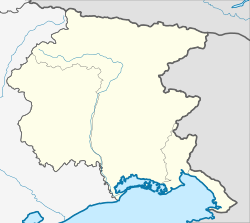Flaibano
Filban (Friulian) | |
|---|---|
| Comune di Flaibano | |
| Coordinates: 46°3′N 12°59′E / 46.050°N 12.983°E | |
| Country | Italy |
| Region | Friuli-Venezia Giulia |
| Province | Udine (UD) |
| Frazioni | S. Odorico al Tagliamento |
| Government | |
| • Mayor | Luca Picco |
| Area | |
| • Total | 17.2 km2 (6.6 sq mi) |
| Elevation | 104 m (341 ft) |
| Population | |
| • Total | 1,193 |
| • Density | 69/km2 (180/sq mi) |
| Demonym | Flaibanesi |
| Time zone | UTC+1 (CET) |
| • Summer (DST) | UTC+2 (CEST) |
| Postal code | 33030 |
| Dialing code | 0432 |
| Website | Official website |
Flaibano (Friulian: Flaiban, locally Filban) is a comune (municipality) in the Regional decentralization entity of Udine in the Italian region of Friuli-Venezia Giulia, located about 80 kilometres (50 mi) northwest of Trieste and about 20 kilometres (12 mi) west of Udine.
Flaibano borders the following municipalities: Coseano, Dignano, San Giorgio della Richinvelda, Sedegliano, Spilimbergo.

Twin towns
[edit]References
[edit]- ^ "Superficie di Comuni Province e Regioni italiane al 9 ottobre 2011". Italian National Institute of Statistics. Retrieved 16 March 2019.
- ^ All demographics and other statistics: Italian statistical institute Istat.
- ^ "Popolazione Residente al 1° Gennaio 2018". Italian National Institute of Statistics. Retrieved 16 March 2019.





Well, that’s interesting to know that Psilotum nudum are known as whisk ferns. Psilotum nudum is the commoner species of the two. While the P. flaccidum is a rare species and is found in the tropical islands. Both the species are usually epiphytic in habit and grow upon tree ferns. These species may also be terrestrial and grow in humus or in the crevices of the rocks.
View the detailed Guide of Psilotum nudum: Detailed Study Of Psilotum Nudum (Whisk Fern), Classification, Anatomy, Reproduction